From Floridata
by
Steve Christman
Morus rubra
Common
Names: red mulberry, American mulberry
Botanical
Family: Moraceae (mulberry family)
Description
Red
mulberry is a rounded, wide spreading tree to 40 ft (12 m) tall with a
spread up to 50 ft (15 m) across. The grayish bark is scaly with
irregular ridges and grooves. Red mulberry has a short trunk that
starts branching low. Cut twigs and leaf stems exude a milky sap. The
leaves are deciduous and alternate, mostly ovate, but usually some
leaves are tri-lobed or mitten shaped, even on the same tree. (It is
usually the younger trees that have the most lobed leaves.) The leaves
are large, up to 5 in (13 cm) long or even larger, with pointed tips,
slightly heart shaped bases and toothed margins. They turn yellow
before dropping in autumn. The mulberries themselves look like elongate
blackberries (Rubus) up to an
inch and a quarter (3 cm) long, starting out red and becoming dark
purple when ripe. Each “fruit” is actually composed of many tiny drupes
packed closely together.
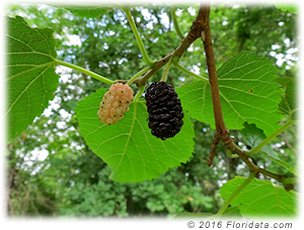
The purple mulberry is ripe and ready to eat, the
white one will be ready in a week or two.
There
are four species of mulberries that can be found growing in the wild in
the US. Only the red mulberry and the Texas mulberry (M. microphylla)
are native; the others have escaped cultivation and are now reproducing
on their own. Red mulberry can be identified by leaves that are rough
(like fine sandpaper) and dull green (not smooth and shiny) on top, and
hairy on the undersides; and young twigs that are hairy (not smooth).
White mulberry (M. alba) has leaves that are smooth and shiny on top, and young stems that are smooth. The leaves of black mulberry (M. nigra) are strongly heart shaped. Texas mulberry has leaves that are much smaller than the others, at just 1-2 in (2-5 cm) long.
Location
Morus rubra
occurs naturally in mixed forests, open woodlands, river valleys and
floodplain forests from the Great Plains, eastward throughout North
America from Ontario to Florida. Red mulberry trees do not form pure
stands, but occur occasionally in forested lowland areas, rarely up to
2300 ft (700 m) in elevation.
The Asian invasive white mulberry (M. alba)
generally occurs in disturbed habitats. It is known to hybridize with
red mulberry. Black mulberry has been reported from just a few
locations in North America and Texas mulberry is found locally in Texas
and southwestern North America.
Culture
Light: Mulberry does best in full sun, and tolerates partial shade quite well.
Moisture: Mulberry likes a moist but well drained soil that is fertile and rich in organics.
Hardiness: USDA Zones 5 - 9 .
Propagation:
Sow seed outdoors in containers in autumn. Cuttings from fast growing
stem tips can be rooted, as can cuttings from semi-ripe stems. Even
rather large sticks of young wood can be used for cuttings.
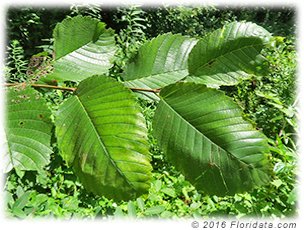
The red mulberry tree has leaves with pointed tips,
slightly heart shaped bases and toothed margins.
Most tree have at least a few tri-lobed or mitten
shaped leaves as well.
Usage
Red
mulberry is cultivated as a specimen tree and for its edible fruits.
The fruits are sweet and used for wines, jams and pies, but, by most
accounts, are not as tasty as those of the introduced white mulberry.
Many kinds of birds and mammals go bonkers over the fruits, though. The
leaves of red mulberry are eaten by caterpillars of the mourning cloak
butterfly.
Native Americans valued red mulberries for food, of
course, but they also used infusions of the roots and bark to treat
intestinal worms, dysentery, and urinary problems.
The wide
spreading habit makes for a beautiful tree that may require occasional
pruning to maintain its desirable shape. Red mulberry is best used in
larger landscapes and parks, and not near clotheslines, sidewalks,
driveways or sitting areas because the fruits and bird droppings can
make a mess. Unfortunately, there are no non-fruiting cultivars
available as there are for white mulberry.
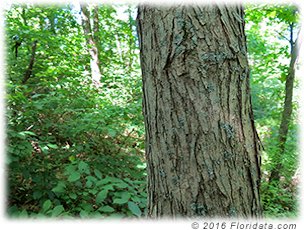
Infusions of red mulberry bark are used in traditional
medicine to treat a number of conditions.
Features
Red
mulberry is listed as Endangered or Threatened in Connecticut,
Massachusetts, Vermont, Michigan and Ontario, due largely to
hybridization with the introduced white mulberry.
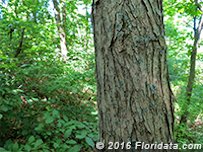 | 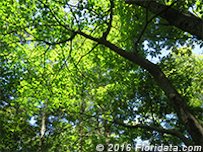 | Trunk and bark of a mature red
mulberry tree | The trunk of this red mulberry tree
curves to reach a sunny patch in
the forest canopy. | 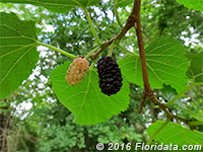 | 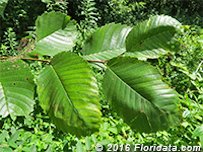 | A ripe purple mulberry is ready to
pick, while the immature fruit has
a week or so before it's ready to
eat.. | Red mulberry leaves |
|
|